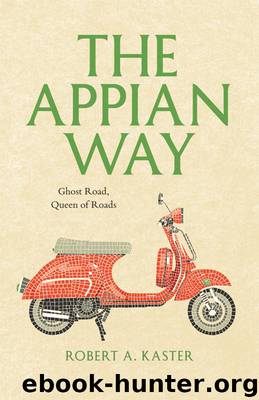The Appian Way by Robert A. Kaster

Author:Robert A. Kaster
Language: eng
Format: epub
Publisher: University of Chicago Press
Published: 2012-01-21T05:00:00+00:00
Figure 11. Pillars at the Appia’s end, Brindisi (left) and Lecce (right)
The towns and cities that the roads originally fostered mostly remain, in one form or another, but the cords of pavement that linked them like pearls on a string have vanished, except for the rare surfacing of a patch here and there, or the remains of an ancient bridge. The scene we found at Aeclanum, near Mirabella Eclano about fifteen miles southwest of Benevento, is typical. A town of the Samnites and then a Roman colony, Aeclanum is the modest sort of country place that the Appia connected with a larger world. It has remains of the baths and amphitheater that any self-respecting Roman town would have wanted. And it produced two notable sons—Velleius Paterculus, one of Rome’s lesser historians (first century CE), and the bishop Julian, a vigorous theological opponent of Saint Augustine (fifth century ce)—before a Byzantine army destroyed it in 663. The baths and amphitheater, along with some streets and other buildings, have been excavated, and they’re worth the modest fee that’s charged for a visit. But when we asked where the via Appia was, the site’s superintendent pointed to a spot about forty feet beyond the excavations, in a field covered with knee-high grass, and indicated that the road itself was perhaps ten feet under ground. That seemed about right: a yard or so for every five hundred years.
So it’s a fair question to ask: how do we know where the ancient roads went? The honest answer is: in most places we don’t know exactly where they went, and in some places we can venture only a very general estimate. A sheep track here and there can give a clue, or a modern road can be taken to approximate the route of the ancient road. (SS7, a good secondary road that runs south from Rome, makes a fair claim to do just that for the Appia.) But of the sequences that the ancient roads followed—from town to resting station to the next town—there can be no doubt, because of resources that have come down to us from ancient times.
The most extraordinary of these is the Tabula Peutingeriana (roughly, “Peutinger’s Painted Panel”), a series of twelve parchment leaves (one now lost) that when joined together as a roll formed a painted map twenty-two feet long and just over a foot wide representing the public roadways of the Roman world, from southeast England to the tip of the Indian subcontinent. Known by the name of the German politician and diplomat who came to possess it in 1508 (Konrad Peutinger, 1465–1547), the roll was produced in 1265 by a monk at Colmar in Alsace, and it is clear that he was working from a model with a very ancient pedigree. With few exceptions, the map contains no features more recent than about the year 300, and there is reason to think that the original version, on which the monk’s model in turn was based, was at least a hundred years older still.
Download
This site does not store any files on its server. We only index and link to content provided by other sites. Please contact the content providers to delete copyright contents if any and email us, we'll remove relevant links or contents immediately.
| Africa | Americas |
| Arctic & Antarctica | Asia |
| Australia & Oceania | Europe |
| Middle East | Russia |
| United States | World |
| Ancient Civilizations | Military |
| Historical Study & Educational Resources |
The Daily Stoic by Holiday Ryan & Hanselman Stephen(2709)
The Fate of Rome: Climate, Disease, and the End of an Empire (The Princeton History of the Ancient World) by Kyle Harper(2436)
People of the Earth: An Introduction to World Prehistory by Dr. Brian Fagan & Nadia Durrani(2346)
Ancient Worlds by Michael Scott(2104)
Babylon's Ark by Lawrence Anthony(2070)
Foreign Devils on the Silk Road: The Search for the Lost Treasures of Central Asia by Peter Hopkirk(2056)
India's Ancient Past by R.S. Sharma(1988)
MOSES THE EGYPTIAN by Jan Assmann(1973)
The Complete Dead Sea Scrolls in English (7th Edition) (Penguin Classics) by Geza Vermes(1842)
Lost Technologies of Ancient Egypt by Christopher Dunn(1798)
The Daily Stoic by Ryan Holiday & Stephen Hanselman(1770)
The Earth Chronicles Handbook by Zecharia Sitchin(1744)
24 Hours in Ancient Rome by Philip Matyszak(1678)
Alexander the Great by Philip Freeman(1650)
Aztec by Gary Jennings(1545)
The Nine Waves of Creation by Carl Johan Calleman(1520)
Curse Tablets and Binding Spells from the Ancient World by Gager John G.;(1510)
Before Atlantis by Frank Joseph(1484)
Earthmare: The Lost Book of Wars by Cergat(1469)
